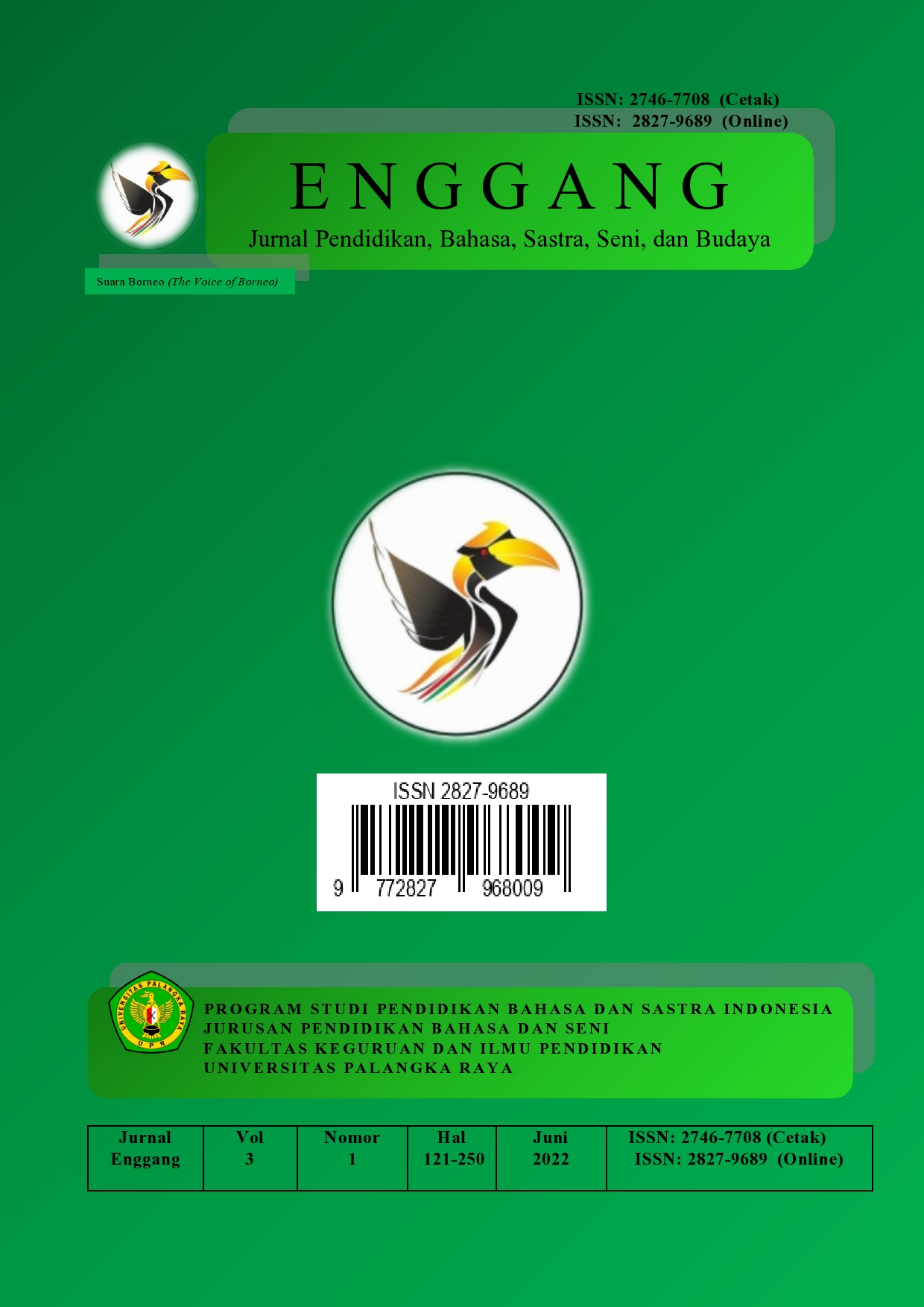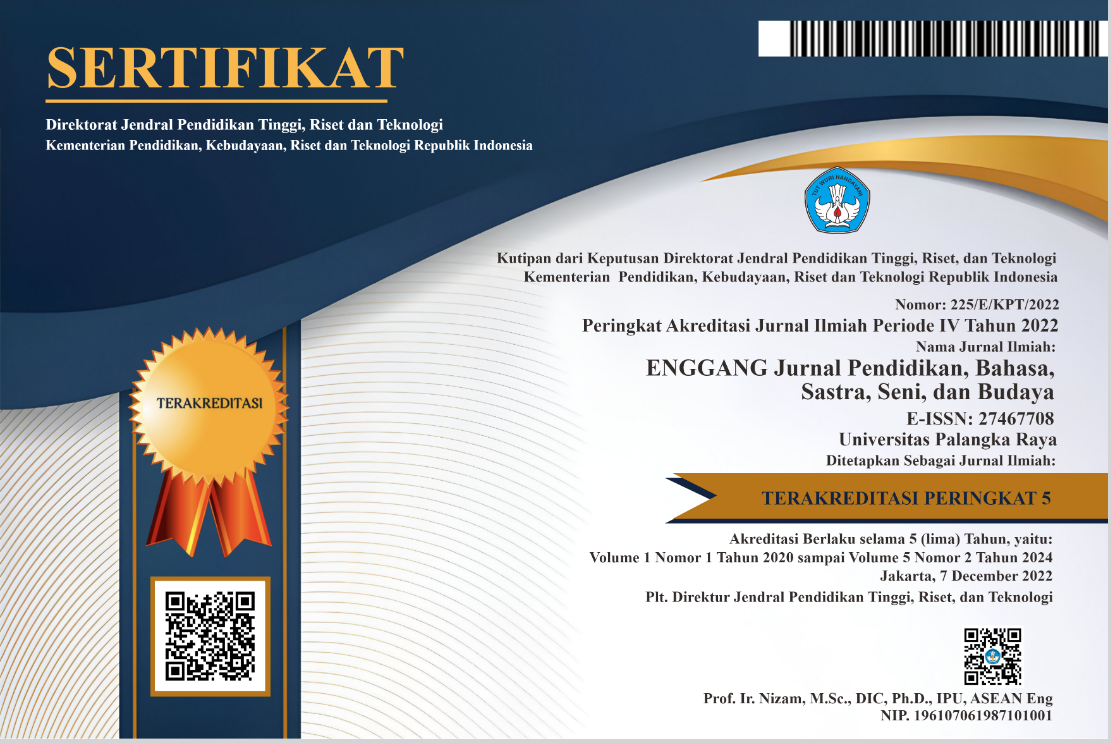Analisis “Lihat Sekitar” Buku Ajar untuk Kelas IV SD/MI Bab 4 (Meliuk dan Menerjang) Tahun 2023 Berbasis Kelayakan Buku BSNP
DOI:
https://doi.org/10.37304/enggang.v5i2.21301Keywords:
textbook, BSNP feasibility, Independent curriculum, feasibility analysis, chapter 4Abstract
Textbooks play an important role in the learning process because they are the main source for students and teachers in achieving the set learning outcomes (CP). However, the suitability of the contents of the textbooks needs to be reviewed to ensure their compliance with national education standards. This study aims to (1) analyze the suitability of the contents of Chapter 4 of the Indonesian Language textbook for grade IV SD/MI based on elements and learning outcomes; (2) evaluate the accuracy and novelty of the material; (3) examine the use of language in delivering the material; and (4) assess the presentation and graphical appearance of the book according to BSNP standards. This study uses a content analysis method with an assessment instrument based on the textbook suitability indicators according to the National Education Standards Agency (BSNP). The object of the study is the Indonesian Language textbook for grade IV SD/MI entitled "lihat Sekitar untuk SD/MI Kelas IV (Revised Edition)" by Eva Nukman and Cicilia Erni Setyowati, especially Chapter IV entitled "Meliuk dan Menerjang". The results of the analysis show that the quality of the book's contents is classified as appropriate and actual, with material that is relevant to the cultural and social context of students. From the language aspect, the book uses correct spelling and language that is straightforward and easy to understand. The presentation of the material is able to arouse students' learning motivation and is equipped with practice questions at the end of the chapter. The quality of the graphics is considered very good with informative illustrations that support students' understanding. The conclusion of this study is that the book is suitable for use in learning with some minor improvements to spelling. It is recommended that authors and publishers pay more attention to punctuation consistency and include exercises that encourage student activity more evenly in each sub-chapter.
Downloads
References
Badan Standar Nasional Pendidikan. (2017). Instrumen penilaian buku teks pelajaran. Badan Standar Nasional Pendidikan.
Departemen Pendidikan Nasional. (2016). Pedoman umum ejaan bahasa Indonesia yang disempurnakan. Pusat Bahasa.
Ferbiyanto, D., Purwandari, I., & Wibowo, B. (2025). Desain grafis dalam buku anak sekolah dasar. Deepublish.
Gunawan, I. (2024). Strategi pembelajaran Bahasa Indonesia berbasis literasi fungsional. Prenadamedia.
Hakim, A. (2023). Evaluasi kualitas visual buku teks anak usia dini. Remaja Rosdakarya.
Handayani, R., Prasetyo, A., & Yuliana, N. (2018). Analisis kelayakan buku Bahasa Indonesia kelas IV SD berdasarkan standar BSNP. Jurnal Pendidikan Dasar, 9(2), 110–119.
Hasanah, N., Pertiwi, R., & Marlina, D. (2024). Model pengembangan buku ajar interaktif. UMM Press.
Ibrahim, M. (2025). Prinsip-prinsip linguistik dalam penulisan buku teks. Unesa Press.
Inderasari, R., Susanto, D., & Yuliani, D. (2021). Bahasa anak dan buku teks sekolah dasar. Alfabeta.
Misnawati, M., Purwaka, A., Nurachmana, A., Cuesdeyeni, P., Christy, N. A., Ramadhan, I. Y., ... & Jumadi, J. (2024). Bahasa Indonesia untuk keperluan akademik era digital. Yayasan DPI.
Mulyasa, E. (2017). Pengembangan dan implementasi Kurikulum 2013. Remaja Rosdakarya.
Prayoga, A. S., Natasya, R. D., & Syaifudin, M. (2024). Analisis kelayakan kegrafikan pada buku ajar Pendidikan Agama Islam dan Budi Pekerti. Ta’dibuna: Jurnal Pendidikan Islam, 13(4), 224–245.
Sanjaya, W. (2018). Perencanaan dan desain sistem pembelajaran. Kencana.
Sari, M., & Hidayat, D. (2020). Analisis kelayakan buku teks Bahasa Indonesia kelas III SD berdasarkan standar BSNP. Jurnal Kependidikan Dasar, 5(1), 1–12.
Sugiyono. (2023). Metode penelitian kualitatif, kuantitatif, dan R&D. Alfabeta.
Tilaar, H. A. R. (2016). Multikulturalisme: Tantangan-tantangan global masa depan dalam transformasi pendidikan nasional. Grasindo.
Waruwu, E. (2024). Analisis buku ajar sekolah dasar berbasis BSNP. Deepublish.
Wulandari, R. (2021). Telaah buku Bahasa Indonesia kelas V SD berdasarkan kriteria BSNP. Jurnal Kajian Pendidikan Dasar, 6(3), 88–97.













